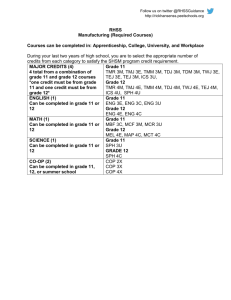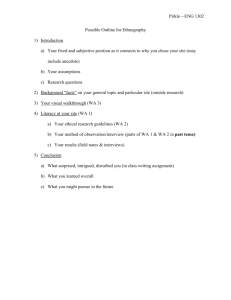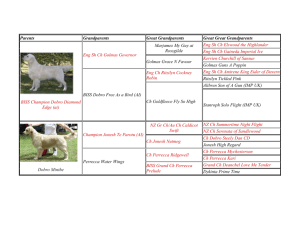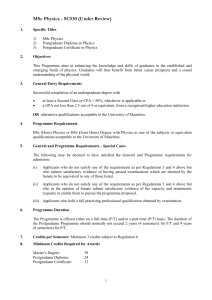november 2009, sl markscheme
advertisement
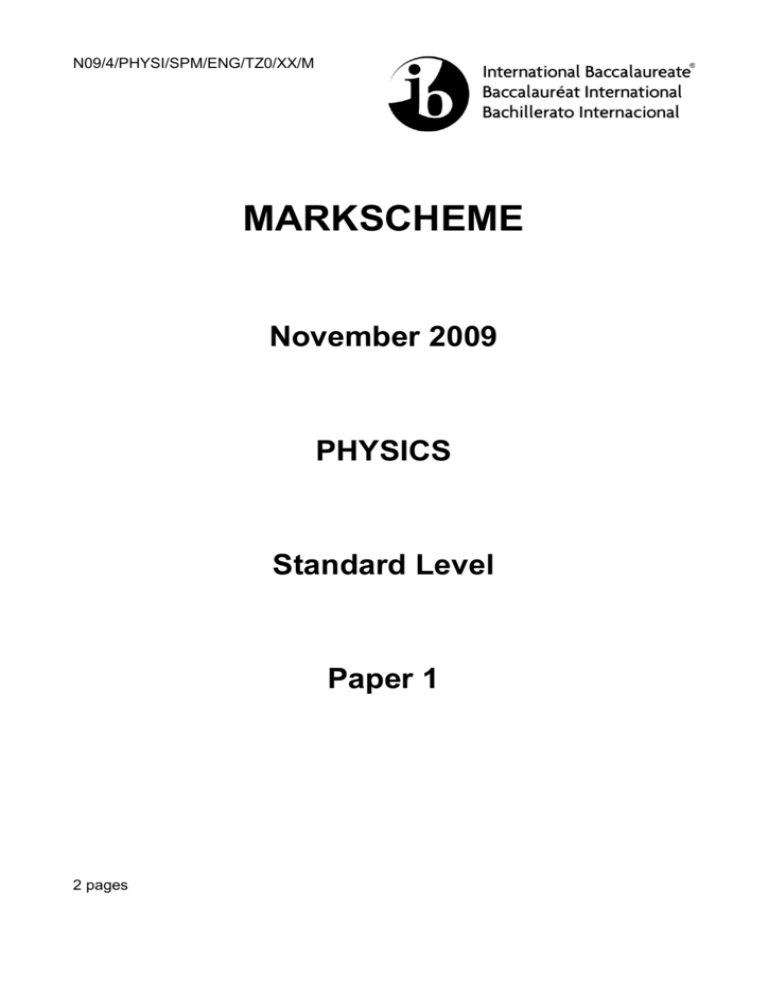
N09/4/PHYSI/SPM/ENG/TZ0/XX/M MARKSCHEME November 2009 PHYSICS Standard Level Paper 1 2 pages –2– N09/4/PHYSI/SPM/ENG/TZ0/XX/M 1. B 16. D 31. – 46. – 2. B 17. B 32. – 47. – 3. A 18. D 33. – 48. – 4. C 19. D 34. – 49. – 5. D 20. A 35. – 50. – 6. A 21. A 36. – 51. – 7. B 22. C 37. – 52. – 8. C 23. B 38. – 53. – 9. B 24. D 39. – 54. – 10. C 25. B 40. – 55. – 11. A 26. B 41. – 56. – 12. D 27. D 42. – 57. – 13. C 28. B 43. – 58. – 14. D 29. D 44. – 59. – 15. C 30. C 45. – 60. – N09/4/PHYSI/SP2/ENG/TZ0/XX/M+ MARKSCHEME November 2009 PHYSICS Standard Level Paper 2 11 pages –2– N09/4/PHYSI/SP2/ENG/TZ0/XX/M+ This markscheme is confidential and for the exclusive use of examiners in this examination session. It is the property of the International Baccalaureate and must not be reproduced or distributed to any other person without the authorization of IB Cardiff. –3– N09/4/PHYSI/SP2/ENG/TZ0/XX/M+ General Marking Instructions Subject Details: Physics SL Paper 2 Markscheme Mark Allocation Candidates are required to answer ALL questions in Section A [25 marks] and ONE question in Section B [25 marks]. Maximum total = [50 marks]. 1. A markscheme often has more marking points than the total allows. This is intentional. Do not award more than the maximum marks allowed for part of a question. 2. Each marking point has a separate line and the end is signified by means of a semicolon (;). 3. An alternative answer or wording is indicated in the markscheme by a slash (/). Either wording can be accepted. 4. Words in brackets ( 5. Words that are underlined are essential for the mark. 6. The order of marking points does not have to be as in the markscheme, unless stated otherwise. 7. If the candidate’s answer has the same “meaning” or can be clearly interpreted as being of equivalent significance, detail and validity as that in the markscheme then award the mark. Where this point is considered to be particularly relevant in a question it is emphasized by writing OWTTE (or words to that effect). 8. Occasionally, a part of a question may require an answer that is required for subsequent marking points. If an error is made in the first marking point then it should be penalized. However, if the incorrect answer is used correctly in subsequent marking points then follow through marks should be awarded. 9. Only consider units at the end of a calculation. Unless directed otherwise in the markscheme, unit errors should only be penalized once in the paper. 10. Significant digits should only be considered in the final answer. Deduct 1 mark in the paper for an error of 2 or more digits unless directed otherwise in the markscheme. ) in the markscheme are not necessary to gain the mark. e.g. if the answer is 1.63: 2 reject 1.6 accept 1.63 accept 1.631 accept 1.6314 reject –4– N09/4/PHYSI/SP2/ENG/TZ0/XX/M+ SECTION A A1. (a) (b) (c) both error bars of 5 m s 1 drawn correctly; [1] a straight line cannot be drawn through the Accept the error bar comment with a error bars; straight line drawn on graph. that goes through the origin; (i) 500 (m 2 s 2 ) ; v2 (ii) v 2 2 [1] v ; v 5 ; 27 ( )300(m2 s 2 ) or v2 [2] 272 2 v2 ( )270 (m 2 s 2 ) ; [3] or percentage error/uncertainty in v (18.5 )19% ; percentage of error/uncertainty in v 2 37 % ; ( )270 (m 2 s 2 ) ; absolute error ( )300 (m 2 s 2 ) or Answer must be to one or two significant figures. (d) 3.0 2.5 2.0 v 2 / 103 m 2 s 2 1.5 1.0 v2 2.3 103 m2 s 4.0 4.5 2 0.5 (T ) 3.6 N 0 0 0.5 1.0 1.5 2.0 2.5 T/N 3.0 3.5 use of gradient triangle over at least half of line; gradient 640( 40) ; k 2 to give k 640 1 2 1 2 25( 1) ; 1 unit of k is kg m or m s 1 N 2 ; Do not penalize omission of factor of 1000 for missing y-axis label if already penalized in (c). Treat as ecf. [4] –5– A2. (a) (i) (ii) (b) (i) (ii) A3. (a) N09/4/PHYSI/SP2/ENG/TZ0/XX/M+ (thermal) energy/heat required to change temperature by 1 K/1 deg/ 1 C / mass specific heat capacity; [1] rate of energy absorption is equal to the rate of energy emission / temperature of copper stays constant; [1] use of mc T ; 0.12 390 [T 308] 0.45 4200 30 ; 1520 K / 1250 C ; [3] energy likely to have been lost when moving copper / during warming of water; hence temperature of flame higher; [2] Symbol Y Gravitational field quantity field strength K (universal) gravitational constant X s 4 mass distance from mass Electrical field quantity field strength; 1 or Coulomb constant; 0 charge; distance from charge; [4] Award [1] for a correct gravitational and electrical field quantity in each row. (b) identifies Fg or identifies Fe or 6.7 10 1.6 10 0 11 19 4 r2 9.1 10 r2 31 1.7 10 27 ; 2 ; (2.3) 1039 ; Allow [1 max] for correct algebraic solution that does not insert numbers. [3] –6– N09/4/PHYSI/SP2/ENG/TZ0/XX/M+ SECTION B B1. Part 1 (a) (i) Pumped-storage power station mass 50 5.0 104 103 ; 4 loss in gpe 50 5.0 10 3 10 310 9.81 ; Accept use of 335 m (including centre of mass of tank water) accept g 10 . 7.6 1012 (J) ; 8 1012 (J) Do not penalize if the first marking point is incorporated into the second marking point. (ii) (b) [3] flows for 6250 s; 1.2 109 W or 1.3 109 W ; Accept solution from (a)(i) or from flow rate. [2] (i) 53% ; [1] (ii) losses in correct order and approximately correct ratio of size; arrows correctly labelled with source of loss; Labelling of width in % is acceptable for correct ratio only. [2] energy output friction heating losses (diagram not to scale) turbulence of water (c) (i) (ii) transmit at high/increased potential difference/voltage; use (step-up) transformer to (increase potential difference/voltage and) reduce current; lower current means I 2R/resistive losses reduced; large cable cross-section/good conductor used for cables so resistive losses reduced; Do not accept discussion of reduction of station distance from consumer. advantage: pumped storage on demand; disadvantage: but needs to be re-stored before re-use; Answer must focus on comparison between tidal and pumped storage. Do not accept arguments based on unreliability of tide or installation costs. [3 max] [2] –7– Part 2 Force and energies (a) zero; (i) N09/4/PHYSI/SP2/ENG/TZ0/XX/M+ [1] (ii) (normal) reaction (normal) reaction force downwards on pedals weight/gravity force/mg correct position and labelling of : weight/gravity force/mg; two reactions drawn as shown; force downwards on pedals; Ignore any other vertical forces and all horizontal forces. The total upward vector lengths should approximately equal the downward vector lengths. [2 max] (iii) drag force thrust/forward force/driving force; net force zero therefore acceleration is zero; [2] (b) 320W ; [1] (c) (i) 40 ; 70 acceleration 0.57 m s 2 ; (ii) use of F s 56 m ; [2] 1 2 mv2 ; [2] or v2 u 2 2as equivalent seen and substituted correctly; 56 m ; (iii) sensible physical reason e.g. air resistance / bearing friction/brakes’ effectiveness varies with speed; attempt at explanation: e.g. air resistance drops as speed drops, underestimate / distance travelled will be further; [2] –8– B2. Part 1 (a) 1. 2. (b) (i) (ii) Simple harmonic motion acceleration proportional to displacement from equilibrium/centre (of motion) /mean position; acceleration directed to equilibrium/centre/mean position; d ; 2 (i) (ii) sine/cosine curve shape reasonable; Do not allow semi-circle for half sine curve. 2 [1] [2] v a2 f seen/used; 3.3m s 1 ; acceleration a 4 9.2 103 m s 2 ; [2] [1] (iii) period labelled; amplitude labelled; (c) N09/4/PHYSI/SP2/ENG/TZ0/XX/M+ [2] f 2 seen/used; [2] –9– Part 2 (a) (b) N09/4/PHYSI/SP2/ENG/TZ0/XX/M+ Electric circuits any circuit in which the current will flow through the lamp; variable resistor connected as a potential divider; voltmeter across lamp; ammeter in series with lamp; [4] correct shape; through origin; [2] I 0 0 V (c) 0.24A ; (d) resistance calculated 5.2( ) ; l A 6.2 10 8 m 2 ; R radius [1] A seen/used; 1.4 10 4 m ; [4] – 10 – (e) N09/4/PHYSI/SP2/ENG/TZ0/XX/M+ calculates resistance of lamps in parallel (2.6 Ω); V Ir used to give V 1.0V ; 1.0 V is lower than 1.25 V / power available to each lamp is 192 mW lower than 300 mW; Award [0] for only stating (terminal pd/power lower) hence not operating normally; this bald answer. Watch for ECF from (d). Award [4 max] for any correct numerical argument involving energy or power calculations. [4] – 11 – B3. Part 1 (a) (i) (ii) N09/4/PHYSI/SP2/ENG/TZ0/XX/M+ Nuclear fission and fusion the energy released when nuclides form from constituents / energy required to separate nucleus into separate nucleons / OWTTE; [1] S marked at maximum of curve (on curve/axis); (judge by eye) [1] (iii) highest binding energy per nucleon; (b) (i) [1] uranium binding energy per nucleon 7.6(MeV) ( 0.1) ; total uranium binding energy 7.6 235 1786 (MeV) ; total Kr Ba binding energy 141 8.4 92 8.7 energy released 1985 1786 198.8(MeV) ; 200MeV (ii) 1985(MeV) ; 2; (iii) one reaction: [1] E 3.1 10 number required 1000 2.8 10 28 11 3 108 2 ( 2.8 10 11 J) ; 3.6 1013 ; (iv) two neutrons produced may cause two further fissions; producing four neutrons which may produce four further fissions; Accept answer in diagram form but it must feature four generated neutrons with only two neutrons giving further fission. (c) [4] nuclear fusion waste much less active than fission waste; fusion fuel much more abundant than fission fuel; fusion fuel has higher energy density than fission; radiation/pollution from plant lower for fusion; [2] [2] [3 max] Part 2 Global warming (a) increased (infra) radiation from the atmosphere to the Earth / OWTTE / increase in the greenhouse effect due to human activity; [1] increase in solar (flare) activity ; Earth orbits closer to Sun; volcanic activity increases global warming (through CO2 emission)/decreases global warming (particles emitted reflect sunlight); [2 max] (i) (ii) (b) (i) (ii) (c) total volume of ice 14 1012 1.5 103 m3 ; mass (2.1 1016 920 )1.9 1019 kg ; [2] new volume 1.9 1016 m3 ; new volume level change ; area of ocean 50 m; [3] oceanic ice displaces a certain amount of sea water/floats on sea water; when it melts the sea water level does not change; [2] N09/4/PHYSI/SP3/ENG/TZ0/XX/M+ MARKSCHEME November 2009 PHYSICS Standard Level Paper 3 15 pages –2– N09/4/PHYSI/SP3/ENG/TZ0/XX/M+ This markscheme is confidential and for the exclusive use of examiners in this examination session. It is the property of the International Baccalaureate and must not be reproduced or distributed to any other person without the authorization of IB Cardiff. –3– N09/4/PHYSI/SP3/ENG/TZ0/XX/M+ General Marking Instructions Subject Details: Physics SL Paper 3 Markscheme Mark Allocation Candidates are required to answer questions from TWO of the Options [2 20 marks]. Maximum total = [40 marks] 1. A markscheme often has more marking points than the total allows. This is intentional. Do not award more than the maximum marks allowed for part of a question. 2. Each marking point has a separate line and the end is signified by means of a semicolon (;). 3. An alternative answer or wording is indicated in the markscheme by a slash (/). Either wording can be accepted. 4. Words in brackets ( 5. Words that are underlined are essential for the mark. 6. The order of marking points does not have to be as in the markscheme, unless stated otherwise. 7. If the candidate’s answer has the same “meaning” or can be clearly interpreted as being of equivalent significance, detail and validity as that in the markscheme then award the mark. Where this point is considered to be particularly relevant in a question it is emphasized by writing OWTTE (or words to that effect). 8. Occasionally, a part of a question may require an answer that is required for subsequent marking points. If an error is made in the first marking point then it should be penalized. However, if the incorrect answer is used correctly in subsequent marking points then follow through marks should be awarded. 9. Only consider units at the end of a calculation. Omission of units should only be penalized once in the paper. 10. Significant digits should only be considered in the final answer. Deduct 1 mark in the paper for an error of 2 or more digits unless directed otherwise in the markscheme. ) in the markscheme are not necessary to gain the mark. e.g. if the answer is 1.63: 2 reject 1.6 accept 1.63 accept 1.631 accept 1.6314 reject –4– N09/4/PHYSI/SP3/ENG/TZ0/XX/M+ Option A — Sight and wave phenomena A1. (a) (i) (ii) (b) Correct positioning of : lens, retina and optic nerve; [1] convert a light signal into an electrical signal; rods are used for black and white vision/contrast/scotopic; cones are used for colour vision/photopic; [3] for objects at different distances from the eye; for the image to be focused; the (ciliary) muscle changes the shape of the lens; [3] A2. The diagram should be as follows: ( b ) wavelength lines shifted all in the same direction; shift in B or the shift in C being noticeably larger than the shift in A; lines shifted right; Award [2 max] if lines are not labelled. [3] –5– A3. (a) (b) A4. (a) (b) N09/4/PHYSI/SP3/ENG/TZ0/XX/M+ 1.22 6.1106 radians; b distance altitude; 6.1106 400 103 2.4 m ; [3] increase the lens diameter; [1] hold the sheets one at a time up to each source and rotate them / OWTTE; the sheet and source which give a variation in intensity upon rotation are the polarizing/polarized ones / OWTTE; [2] the solution rotates the plane of polarization; light from polarized source is rotated by the solution; the degree of rotation is measured by rotating the polarizing filter; the angle of rotation gives an indication of the solution concentration / OWTTE; measure angle of rotation for a standard solution; [4 max] apparatus is: ( b ) polarized source sugar solution polarizing filter with protractor attached –6– N09/4/PHYSI/SP3/ENG/TZ0/XX/M+ Option B — Quantum physics and nuclear physics B1. (a) (b) 6.63 1034 2.11015 3.6 5.1eV ; 1.6 1019 (i) E hf work function (ii) no change since energy depends only on frequency; (i) p mv p 2 E m ; h h ; p 2Em 6.6 1034 2 5.0 10 1.6 10 3 (ii) 19 9.11031 [1] [1] ; 1.7 10 11 m ; [4] experiments show that electrons can be diffracted; therefore they must be waves; [2] or Outline of scattering experiment e.g.: electrons scattered from a crystal; form regions of maximum and minimum / OWTTE; (c) (i) (ii) B2. (a) (b) electron is confined by the box; therefore only certain wavelengths allowed; the energy of the electron is related to its wavelength; [3] each line is a well defined single frequency; which corresponds to a single photon energy; arising from electron transitions between discrete energy levels; [3] or I 124 52 X v nucleon number 124; proton number 52; v; 124 53 124 53 0 I 124 52 X 1 e v [3] 0.17 days 1 ; A 810e0.176 ; A 290Bq ; [3] –7– N09/4/PHYSI/SP3/ENG/TZ0/XX/M+ Option C — Digital technology C1. (a) (i) 12 V; [1] (ii) 1100; [1] (iii) 0; it has the least effect on the value (of the number) / the value of the voltage is an even denary number / the last digit on the right of the number; [2] (b) diagram showing light reflected from flat and edge of pit; if there is just the right depth; light reflected from the edge of a pit and flat interfere destructively such that there is 0 intensity at the detector; light reflected from the flat/pits is a 0; Accept answers in terms of non-reflective pit ( 0) and reflective flat/land ( 1) system. (c) pd across 10 k Vin 1.0 104 I ; pd across 50 k 7.0 5.0 104 I ; I 1.4 104 A ; Vin 1.0 1.4 104 104 2.4V ; or pd across 50 k 50 Vin 6.0 ; 60 7.0V ; 50Vin 300 420 ; Vin 2.4 V ; Award [4] if third marking point is omitted and answer is correct. Award [4] for any other valid method that gives correct answer. [4] [4] –8– C2. (a) (b) N09/4/PHYSI/SP3/ENG/TZ0/XX/M+ the ratio of charge to potential difference/voltage; (i) (ii) 1.2 103 2.6 1015 ; 19 4.6 10 number of photons per second on pixel 2.6 1015 5.5 1010 ; 1.4 106 s 1 [1] number of photons per unit area per second [2] charge emitted per second 1.4 106 1.6 1019 2.3 1013 (C) ; pd per second (V ) Q ; C 2.3 1013 0.1(V) ; 12 2.2 10 4.0 105 time to reach 40µV 0.40 ms ; 0.1 (iii) the quantum efficiency is unity (1)/100 % / each incident photon ejects an electron from the pixel; [4] [1] –9– N09/4/PHYSI/SP3/ENG/TZ0/XX/M+ Option D — Relativity and particle physics D1. (a) (b) a reference frame that is not accelerating/moving with constant velocity / in which Newton’s first law is valid / OWTTE; (i) (ii) Aibhe since proper length is defined as the length of the object measured by the observer at rest with respect to the object / since she is at rest with respect to the object; [1] [1] L0 ; L 1.50 1.25 ; 1.20 v2 1 or other evidence of algebraic manipulation; 2 c 1.252 v 0.60c or 1.8 108 m s 1 ; 1 (c) 3.0s ; (d) (because) the speed of light is the same for all inertial observers; and because of their relative motion Aibhe and Euan will measure different time intervals for the two events; events which are simultaneous for Aibhe will not be simultaneous for Euan; (vice versa) [4] [1] [3] – 10 – D2. (a) (b) (c) (d) N09/4/PHYSI/SP3/ENG/TZ0/XX/M+ two or more fermions with identical quantum numbers cannot occupy the same energy level/quantum state; (whereas) bosons with identical quantum numbers can (occupy the same energy level/quantum state); Award [1 max] for “fermions obey the PEP, bosons do not”. [2] (i) photon; [1] (ii) pion/meson/gluon; [1] h ; 4Rc 6.6 1034 m 0.18 1027 kg ; 8 15 4 3.14 3 10 10 27 0.18 10 940 or evidence of other suitable conversion; 1.68 1027 100MeV m (i) [3] meson: (positive) – because refers to quark sentence / up quark has charge 23 and anti-down quark has charge 13 ; anti-muon: (positive) – because muon has negative charge; [2] Allow arguments in terms of charge conservation for one or other particle. To award the mark the reason must be correct. (ii) W / positively charged vector boson; [1] – 11 – N09/4/PHYSI/SP3/ENG/TZ0/XX/M+ Option E — Astrophysics E1. (a) (i) (ii) (b) (i) (ii) gives the relative (visual) brightness of stars as seen from Earth; e.g. a magnitude 1 star is 100 times brighter than a magnitude 6 star; To award [2] the idea of a relative scale must be clear. [2] the apparent magnitude a star would have if it were 10 pc from Earth; [1] d mM ; 10 5 1.03 ; d 10 101.03 ; 108pc Accept answer based on substitution for d 108. log [3] L 4d 2 b ; LB d 2b B2 B ; LSun dSun bSun LB 108 2.05 1010 7.00 1012 LSun ; 2 3.43 103 LSun Accept answer based on substitution LB 3.43 LSun . (c) in the region 30 50, 2.5 5.0 ; [3] [1] (d) –10 –5 absolute magnitude 0 +5 40 20 10 5 2.5 temperature / K 103 Cepheid as shown; Judge by eye for reasonable range of magnitude and temperature. (e) (f) [1] the outer layers undergo a periodic expansion and contraction/periodic fluctuations in temperature; [1] period/frequency with which luminosity varies; apparent brightness / apparent magnitude; [2] – 12 – E2. (a) N09/4/PHYSI/SP3/ENG/TZ0/XX/M+ Newton’s model assumed a uniform infinite (and static) universe; therefore number of stars in shell is proportional to R 2 ; 1 ; R2 since according to Newton’s model such shells stretch to infinity / the sky can never be dark/will always be light / OWTTE; intensity of radiation/light from shell reaching Earth is proportional to (b) the universe is expanding; the universe has a beginning; the stars (and galaxies) are not uniformly distributed; [4] [2 max] – 13 – N09/4/PHYSI/SP3/ENG/TZ0/XX/M+ Option F— Communications F1. (a) (b) (c) (d) signal wave: the wave that carries information about the source / the information wave; carrier wave: the wave that transmits information from transmitter to receiver / the wave that is modulated by the signal wave; [2] AM varies the amplitude (of the carrier wave) and FM varies the frequency (of the carrier wave); [1] A B: constant/no change; B C: increasing; C D: decreasing; [3] 1 1 ; fS 3 T 1.2 10 830Hz ; [2] (i) (ii) F2. (a) (i) (ii) (b) (c) 2.2 105 ; 1.2 103 180MHz or 1.8 108 Hz ; fC [2] sampling frequency 104 (s 1 ) ; bit rate( number of bits sampling frequency) 30 kb s 1 ; [2] at 500µs output 3.6V ; therefore digital output 111 ; [2] increasing the sampling frequency means smaller increments of voltage will be measured; increasing number of bits means that that sampled voltage can be represented more accurately; some conclusion e.g. the digital encoding will be a more accurate/faithful representation of the analogue signal; I where I input power and I 0 output power; I0 (i) 10 lg (ii) dB loss (10lg 4 )6.0dB ; distance 3.0km ; [3] [1] [2] – 14 – N09/4/PHYSI/SP3/ENG/TZ0/XX/M+ Option G — Electromagnetic waves G1. (a) (b) G2. (a) the field oscillates too fast for the compass to respond; the field is too weak; [1 max] (i) 1019 Hz ; (or above) (ii) difficult to modulate the source (which will be a nuclear explosion/ radioactive decay); difficult to build an appropriate receiver/detector; negative health effects of exposure to gamma-rays; white light [1] [1 max] convex lens red principal axis blue red blue white light paths as shown: red ray focused; blue ray focused; Allow [1 max] if colours reversed. (b) (c) (d) [2] a different image is formed for each colour of light in the white light; therefore the resulting image will be multi-coloured; and out of focus; [3] use a lens of very long focal length / use a compound lens / use a diffractive optical element / achromatic doublet; [1] (i) (ii) 1 1 1 1 1 1 ; u v f v 8 5 v 13cm ; [2] 2.6 ; [1] use of – 15 – G3. (a) (i) coherent source; (ii) d and spacing L spacing L N09/4/PHYSI/SP3/ENG/TZ0/XX/M+ [1] d or use of s D d ; 2.0 700 109 spacing 2.8mm ; 5 104 (b) [2] (iii) sharpen the maxima / finer maxima; greater contrast between minimum and maximum / brighter maxima; [2] use of d sin n ; with 90, n 4 ; number 9 ; [3]



